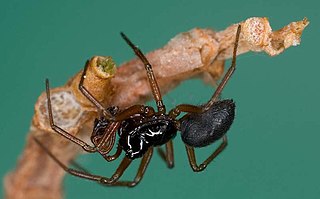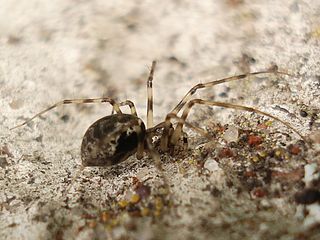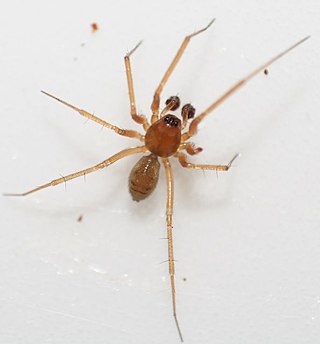
Linyphiidae, spiders commonly known as sheet weavers, or money spiders is a family of very small spiders comprising 4706 described species in 620 genera worldwide. This makes Linyphiidae the second largest family of spiders after the Salticidae. The family is poorly understood due to their small body size and wide distribution; new genera and species are still being discovered throughout the world. The newest such genus is Himalafurca from Nepal, formally described in April 2021 by Tanasevitch. Since it is so difficult to identify such tiny spiders, there are regular changes in taxonomy as species are combined or divided.

Erigoninae are the largest subfamily of sheet weavers (Linyphiidae), which is itself the second largest spider family. In the United States they are known as dwarf spiders, while they are called money spiders in England. The exact taxonomic limits of the subfamily are not yet known.

Araniella cucurbitina, sometimes called the "cucumber green spider", is a spider of the family Araneidae. Araniella cucurbitina is found across Europe, Western Asia, Central Asia and Japan. The cucurbitina in the name comes from the word cucurbit which is a family of plants including cucumbers.

Tegenaria parietina is a species of spider native to Europe. Its modern day distribution includes area from Northern Africa to Central Asia and Sri Lanka, and from the West Indies to Uruguay and Argentina, where it may have been introduced. In the UK - where it is the largest native species of spider - it is sometimes known as the cardinal spider, because of the legend that Cardinal Wolsey was terrified by this species at Hampton Court, or, conversely, because he regarded them as lucky and forbade anyone to harm them. In 2013, Tegenaria taprobanica was included in this species.

Drapetisca socialis is a species of spider belonging to the family Linyphiidae. It is distributed across most of the Palearctic region.
Tenuis, weak or slender in Latin, and a species in zoology, may refer to:

Attulus inexpectus is a species of spider from family Salticidae, found in from Europe to central Asia. It was previously misidentified as Attulus rupicola.

Linyphia triangularis is a European species of spider in the family Linyphiidae first described by Carl Alexander Clerck in his 1758 Svenska Spindlar.

Neriene montana is a species of spider belonging to the family Linyphiidae. With a holarctic distribution, it is found throughout northern Europe.

Scotophaeus blackwalli, also known as the mouse spider, is a species of spider belonging to the family Gnaphosidae.

Dictyna arundinacea is a species of spider belonging to the family Dictynidae. It has a holarctic distribution; It is found throughout Britain and northern Europe.

Lepthyphantes minutus is a species of spider belonging to the family Linyphiidae. Despite its name it is one of the larger species of Lepthyphantes. It is found throughout Northern Europe.

Tenuiphantes is a genus of sheet weavers that was first described by Michael I. Saaristo & A. V. Tanasevitch in 1996.
Perennial ryegrass staggers is poisoning by peramine, lolitrem B, and other toxins that are contained in perennial ryegrass, and produced by the endophyte fungus Epichloë festucae which can be present in all parts of the grass plant, but tends to be concentrated in the lower part of the leaf sheaths, the flower stalks and seeds. This condition can affect horses, cattle, sheep, farmed deer and llamas. It regularly occurs in New Zealand and is known spasmodically from Australia, North and South America, and Europe.

Listronotus bonariensis is a species of weevil that is native to South America and is commonly known as the Argentine stem weevil. It is a pest of grasses and cereals, with the larvae being more destructive than the adult insects. It has spread to Australia and New Zealand, where it is regarded as a pest species.

Aphantaulax trifasciata is a species of ground spider in the genus Aphantaulax, family Gnaphosidae.
Tenuiphantes zebra is a species of sheetweb spider in the family Linyphiidae. It is found in North America.
Tenuiphantes sabulosus is a species of sheetweb spider in the family Linyphiidae. It is found in North America.
Tenuiphantes zibus is a species of sheetweb spider in the family Linyphiidae. It is found in North America.














